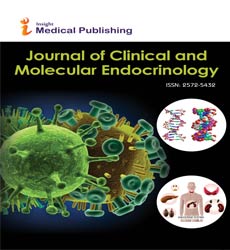Diseases brought about by Chromosome Abnormalities
Smaran R*
Department of Endocrinology, Indira Gandhi Medical College, Shimla, India
- Corresponding Author:
- Smaran R
Department of Endocrinology
Indira Gandhi Medical College, Shimla, India
Tel: 0753426789
E-mail: Smaran39@yahoo.com
Received: October 26, 2021; Accepted: November 09, 2021; Published: November 16, 2021
Citation:Smaran R (2021) Diseases brought about by Chromosome Abnormalities. J Clin Mol Endocrinol. 2021, 6:6.60
Introduction
Such lopsided characteristics regularly disturb enormous quantities of measurement delicate, formatively significant qualities and result in explicit and complex aggregates. Then again, some chromosomal disorders might be brought about by an erasure or duplication of a solitary quality with pleiotropic impacts. Generally, chromosome anomalies were distinguished by visual review of the chromosomes under a magnifying lens [1]. The utilization of sub-atomic cytogenetic advancements, for example, fluorescence in situ hybridization and microarrays, has took into consideration the recognizable proof of obscure or submicroscopic lopsided characteristics, which are not apparent under the light magnifying lens. Microarrays have took into consideration the recognizable proof of various new conditions through a genotype-first methodology in which patients with the equivalent or covering genomic changes are distinguished and afterward the aggregates are portrayed.Numeric anomalies are more endured for the sex chromosomes and just certain autosomes. The most well-known monosomy is that for the X chromosome (45, X) found in Turner condition.
Trisomy, the presence of three, rather than two, duplicates of a specific chromosome, causes Down condition, or trisomy 21, and happens in around 1/800 live births. Other normal trisomies incorporate trisomy 13 and 18. Mosaicism for a typical cell line and a strange cell line might happen in a solitary person. Some underlying chromosome anomalies bring about gain or loss of material [2]. Erasures include the departure of a section of a chromosome and duplications bring about an increase of a chromosome fragment. Erasures might be terminal or interstitial; a terminal cancellation results later one break in the chromosome with loss of the fragment distal to the break, while an interstitial cancellation results later two breaks in the chromosome, with the deficiency of the mediating portion, and rejoining of the leftover chromosome sections. People with the disorder have serious mental hindrance, development impediment, dysmorphic facial highlights, dainty and meager hair, taking care of troubles, and separated or high sense of taste. Despite the fact that cancellations of shifting sizes have been accounted for, the littlest district erased in all patients contains no less than seven qualities. One of these qualities, SATB2, is a DNA-restricting protein that manages how qualities are communicated. Erasure of SATB2 has been proposed to cause the separated or high sense of taste of people with 2q32q33 micro deletion condition [3].
Telomeres are specific protein-DNA structures at the closures of all direct chromosomes that assume various significant cell parts, including the avoidance of chromosome corruption and start to finish chromosome fusions,18 just as the appropriate blending, recombination, and isolation of chromosome homologs during meiosis.19 Telomeric DNA comprises of pair rehashes of basic G-rich successions that show wonderful preservation all through eukaryotic advancement. All human chromosomes end with roughly 2–20 kb of the basic couple rehash (TTAGGG)n.20 Proximal to this telomeric rehash parcel is a fundamentally mind boggling area of subtelomeric DNA that can expand a few hundred kb from the finish of most chromosomes and has been demonstrated to be exceptionally polymorphic[4]. 21–24 Present on everything except the short arms of acrocentric chromosomes 13–15 and 21–22, the one of a kind subtelomeric areas have inspired review since they are generally quality rich25,26 and are inclined to reworking by various instruments.
Conclusion
The aggregates are frequently perplexing, and the aftereffect of an increase or loss of numerous, measurements touchy qualities in the modified portions. The portrayal of these mind boggling aggregates with covering erasures has considered the recognizable proof of qualities causing specific highlights of the disorder. The utilization of high-goal advancements, for example, microarrays, has took into account the distinguishing proof of new disorders through a genotype-first methodology at a phenomenal recurrence up until recently never envisioned through the light magnifying instrument.
References
- Wolf U, Reinwein H, Porsch R, Schroter R, Baitsch H. (1965) Deficiency on the short arms of a chromosome No. 4.Humangenetik1:397–413.
- Sharp AJ, Hansen S, Selzer RR, (2006) Discovery of previously unidentified genomic disorders from the duplication architecture of the human genome.Nat Genet 38(9):1038–1042.
- Sharp AJ, Selzer RR, Veltman JA, (2007) Characterization of a recurrent 15q24 microdeletion syndrome.Hum Mol Genet16(5):567–572.
- Cooper JP. (2000) Telomere transitions in yeast: the end of the chromosome as we know it.Curr Opin Genet Dev10(2):169–177.
Open Access Journals
- Aquaculture & Veterinary Science
- Chemistry & Chemical Sciences
- Clinical Sciences
- Engineering
- General Science
- Genetics & Molecular Biology
- Health Care & Nursing
- Immunology & Microbiology
- Materials Science
- Mathematics & Physics
- Medical Sciences
- Neurology & Psychiatry
- Oncology & Cancer Science
- Pharmaceutical Sciences
